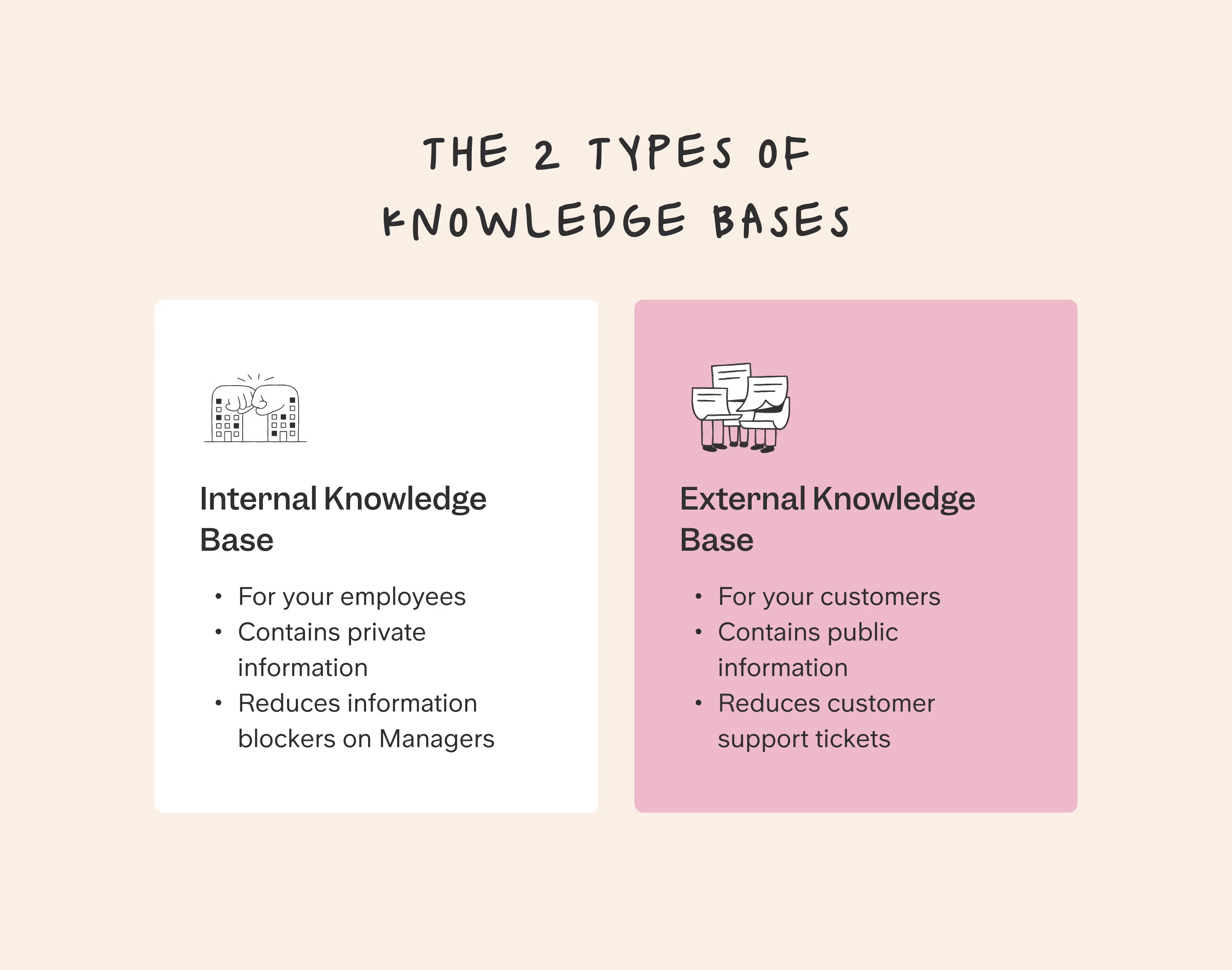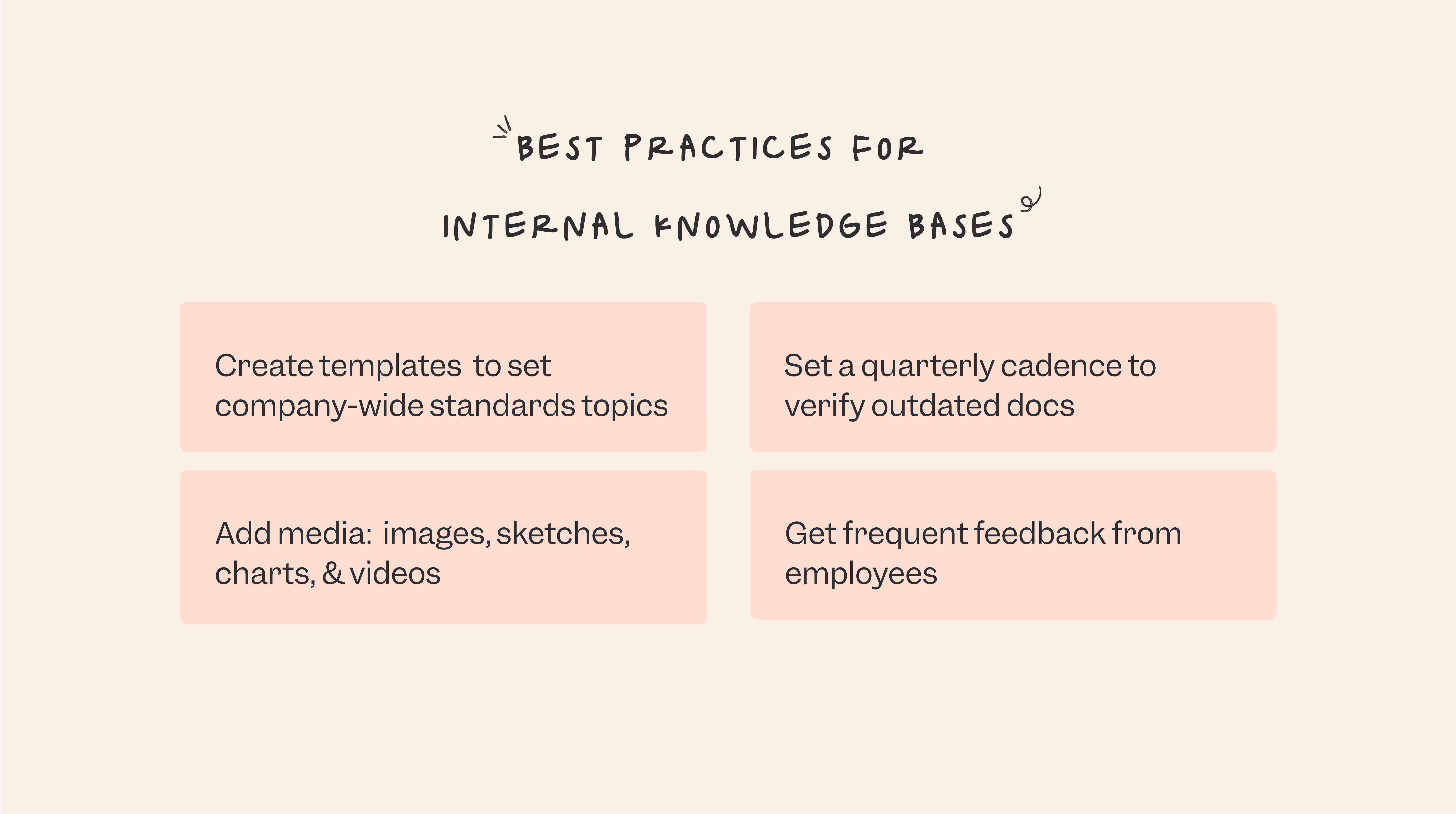Where does your team's real work happen?
On Slack? Or on MS Teams? Or is it on Zoom calls (that could've been an email)?
Traditionally, work happens where you communicate. And that creates a huge information problem for companies.
But there's no better way, is there?
Enter: The Internal Knowledge Base.
It's the central hub where all your company's knowledge, from meeting notes to project plans, comes to live, thrive, and be easily found by anyone who needs it. No more digging through ancient email chains or trying to remember that one thing Dave said in a meeting three months ago.
"But wait," you might be thinking, "isn't that just another place for docs to go and die?"
Nope, not if you do it right! A well-crafted Internal Knowledge Base is a living, breathing ecosystem that evolves with your team. It's not just a graveyard for old Google Docs, but a vibrant library of knowledge that actually makes your team smarter and faster.
And the best part? It's not just some trendy employee productivity hack. Internal Knowledge Bases are a legit game-changer for companies of all sizes, from scrappy startups to Fortune 500 behemoths.
So buckle up, because we're about to dive deep into the wonderful world of Internal Knowledge Bases. You'll learn what they are, why you desperately need one, and how to build an Internal Knowledge Base.
What Exactly Is an Internal Knowledge Base?
An Internal Knowledge Base is a centralized, searchable repository for all the internal information your own development team really needs to do their best work. It's like a digital brain that stores everything from company policies and project documentation to meeting notes and best practices. It's one of the 2 types of Knowledge Bases.

But here's the key: It's not just a dumping ground for random files and folders. A truly effective Internal Knowledge Base is carefully organized, easy to navigate, and constantly evolving to keep up with your team's needs.
Think of it like a well-curated library. Just like a library has sections for different genres and topics, an Internal Knowledge Base has clear categories and structure. This makes it a breeze for anyone to find the relevant information that they need, whether they're a new hire trying to get up to speed or a veteran employee looking for that one crucial detail.
But the real magic of an Internal Knowledge Base software lies in its ability to break down silos and foster collaboration. When everyone has access to the same information, it levels the playing field and empowers people to work together more effectively. No more wasting time tracking down that one person who always seems to have the answers – with an Internal Knowledge Base tool, the answers are right at your fingertips.
Now, I know what you might be thinking: "This sounds great, but do we really need another tool in our already cluttered tech stack?" Trust me, once you experience the power of an Internal Knowledge Base firsthand, you'll wonder how you ever survived without one.
Why You Can't Afford to Ignore Internal Knowledge Bases
Still not convinced that an Internal Knowledge Base is worth the investment? Let me paint a picture of what life looks like without one.
Scenario 1: You need to find a needle in a haystack
You're working on a critical project when you realize you need a piece of information from a meeting that happened months ago. You spend hours digging through old emails, Slack threads, and Google Drive folders, but you just can't seem to find it. Frustration mounts as you waste precious time on a wild goose chase instead of actually getting work done.
Scenario 2: A veteran leaves
Your company's top salesperson, who's been with the organization for years, decides to take a new job. They walk out the door, taking years of valuable knowledge and expertise with them. Suddenly, your sales team is scrambling to fill in the gaps, and deals start falling through the cracks.
Scenario 3: Your team's distributed and un-aligned on everything
Your team is spread across different offices, time zones, and even continents. Without a central hub for information, collaboration becomes a nightmare. People are working with outdated documents, duplicating efforts, and constantly asking each other for help finding things. Productivity takes a nosedive, and morale of support team starts to suffer.
Sound familiar? These are just a few of the costly consequences of not having an Internal Knowledge Base. But it doesn't have to be this way.
With an Internal Knowledge Base, you can:
- Save time and boost productivity by making it easy for people to find the information they need, when they need it.
- Retain valuable institutional knowledge, even when key employees leave the company.
- Foster a culture of collaboration and knowledge-sharing across teams and departments.
- Onboard new hires faster and more effectively by giving them access to a comprehensive resource library.
- Make better, more informed decisions by ensuring everyone has access to accurate, up-to-date information.
And the best part? Getting started with an Internal Knowledge Base is easier than you might think.
How do you build an internal Knowledge Base?
To build an internal Knowledge Base, use Slite's Wiki Generator. Answer a couple questions GPT-style and see your internal Knowledge Base example get built in real-time for free.
And if you'd like to start from scratch,
It all comes down to three key ingredients: structure, engagement, and maintenance.
Ingredient #1: Structure
The first step to building an Internal Knowledge Base that doesn't suck is to give it a clear, logical structure. This means creating a hierarchy of categories and subcategories that make sense for your organization.
For example, you might have top-level categories like "HR," "Marketing," and "Product," with subcategories like "Benefits," "Social Media," and "Roadmap" underneath. The key is to make it intuitive and easy to navigate, so people can find what they need without having to think too hard.
Another crucial aspect of structure is metadata. This is the information that describes each piece of content, like tags, authors, and creation dates. By adding metadata to your Internal Knowledge Base, you make it much easier to search and filter information later on.
Ingredient #2: Engagement
Here's a hard truth: You can build the most beautiful, well-structured Internal Knowledge Base in the world, but if no one uses it, it's worthless. That's why engagement is so crucial.
To get people on board with your Internal Knowledge Base, you need to make it a core part of your company culture. This means leading by example and using it yourself, as well as encouraging (or even requiring) others to do the same.
One effective strategy is to gamify the process of contributing to the Internal Knowledge Base. This could mean offering rewards or recognition for people who create high-quality content or share their knowledge regularly. You could even make it a friendly competition between teams or departments.
Another key to engagement is making it dead-simple for people to contribute. The easier it is to add content to your Internal Knowledge Base, the more likely people will be to do it. Look for tools that offer intuitive interfaces, easy formatting options, and seamless integrations with the apps your team already uses.
Ingredient #3: Maintenance
The final piece of the puzzle is maintenance. An Internal Knowledge Base is a living, breathing thing, and like any living thing, it needs regular care and feeding to stay healthy.
This means appointing dedicated knowledge managers (or "librarians," if you will) to keep things organized and up-to-date. These folks are responsible for regularly reviewing content, archiving outdated information, and ensuring that the structure and metadata remain relevant over time.
It also means establishing clear guidelines and best practices for creating and maintaining content. This could include things like standardized formatting, naming conventions, brand guidelines, and approval processes to ensure quality control.
By investing in ongoing maintenance, you ensure that your Internal Knowledge Base remains a valuable, trustworthy resource for your team, even as your organization grows and evolves.
Putting It All Together
Structure, engagement, project management, and maintenance: These are the three pillars of a truly usable Internal Knowledge Base. But of course, knowing what to do is only half the battle.

The Best Tools for Building Your Internal Knowledge Base
Now that you know a few best practices what goes into creating an awesome Internal Knowledge Base, let's talk about the tools that can help you make it happen.
Option 1: The Wiki Way
One of the most popular options for building an Internal Knowledge Base is a wiki-style platform. These tools, like Atlassian's Confluence or MediaWiki (the software that powers Wikipedia), are designed specifically for creating and organizing internal company knowledge base.
The great thing about wikis is that they're collaborative by nature. They make it easy for multiple people to contribute, edit, and comment on content, which can help foster a sense of shared ownership and responsibility for the whole create an Internal Knowledge Base.
Wikis also tend to have robust search and tagging features, which can make it easier for people to find the information they need quickly. And many wiki platforms offer templates and other formatting tools to help ensure consistency and readability.
Option 2: The Document Dynamo
Another approach is to use a document-centric tool like Google Docs, Microsoft SharePoint, or Dropbox Paper. These platforms are designed for creating and sharing individual documents, but they can also be used to build a structured Internal Knowledge Base.
The advantage of this approach is that most people are already familiar with these tools, which can help with adoption and engagement. They also tend to have strong collaboration features, like real-time co-editing and commenting.
However, the drawback is that these tools may not have the same level of organization and structure as a dedicated wiki platform. You may need to put in extra effort to create a clear hierarchy and metadata system.
Option 3: The All-in-One Approach
For a more integrated solution, you might consider an all-in-one platform like Notion. This tool combines the best of both worlds, offering the flexibility of documents with the structure and organization of a wiki.
With an all-in-one platform, you can create a single, centralized hub for all your team's knowledge and resources. You can build hierarchies, add metadata, and link related content together seamlessly. Plus, Notion offers additional features like task management, databases, and more.
The downside is that these platforms may have a steeper learning curve than more familiar tools like Google Docs. They also tend to be pricier than standalone document or wiki tools.
Option 4: The Knowledge Base Specialist
Slite is a dedicated knowledge base platform that's designed from the ground up to help teams capture, organize, and share their collective knowledge. It offers a clean, intuitive user friendly interface, that makes it easy to create and navigate content, plus powerful features like full-text search, customizable templates, and seamless integrations with the tools your team already uses.
But what really sets Slite apart is its innovative use of AI to make knowledge management smarter, faster, and more effective. With Slite's AI-powered formatting feature, you can transform rough notes and bullet points into beautifully formatted documents with just a single click. No more wasting time fiddling with fonts and spacing – Slite's AI does the heavy lifting for you.
And when it comes to finding the information you need, Slite's AI-powered search function is in a league of its own. Not only can you search within Slite itself, but you can also invoke Slite's search functionality from anywhere, whether you're in Slack, your browser, or any other app. Just type in your query and let Slite's AI do the rest, serving up the most relevant knowledge from your base in seconds.
What's more, Slite's AI is always learning and improving based on your team's interactions with the platform. Over time, it gets better at understanding your organization's unique language and context, making it easier than ever to find the knowledge you need when you need it.
Beyond traditional knowledge bases: connecting your entire information ecosystem
While Slite excels at organizing structured documentation, our team recognized that critical knowledge lives everywhere - not just in formal knowledge bases. Important context exists in Slack conversations, project decisions are made in Linear, technical discussions happen in GitHub, and strategic insights are scattered across Google Drive files.
This insight led us to build Super.work, an AI-powered enterprise search platform that connects all your company tools into one intelligent interface. Instead of teams hunting through multiple platforms to piece together complete information, they can ask natural language questions like "What's our customer onboarding process?" and get comprehensive answers with source citations from across all platforms.
Together, Slite and Super create a complete knowledge ecosystem: Slite for structured internal documentation and collaboration, Super for unified search across your entire information landscape. This combination ensures no critical knowledge gets trapped in tool silos while maintaining the simplicity and AI-powered intelligence that makes knowledge management truly effective.
Making the Right Choice
Ultimately, the best tool for your Internal Knowledge Base will depend on your team's specific needs, preferences, and budget. The key is to choose a platform that balances ease of use with robust features and customization options.
If you're looking for a dedicated solution that's built from the ground up for knowledge sharing and collaboration, we've rounded the 15 best Knowledge Bases in the market right now.
The Future of Internal Knowledge Bases: AI, Automation, and Beyond
As we've seen, the world of Internal Knowledge Bases is already being transformed by cutting-edge technologies like artificial intelligence. But what does the future hold? Here are just a few of the exciting trends and innovations that are shaping the future of internal knowledge base software and informational resource management.
Trend #1: AI-Powered Everything
We've already seen how AI can streamline content creation, manage projects, supercharge search, and make company knowledge base management smarter and more efficient. But that's just the beginning. In the coming years, we can expect to see AI being applied to every aspect of Internal Knowledge Bases, from personalized content recommendations to automated content curation and beyond.
Imagine creating an Internal Knowledge Base that can automatically tag and categorize content based on its meaning and context, or that can suggest related articles and experts based on the topic you're exploring. With AI, the possibilities are endless.
Trend #2: Seamless Integration
Another key trend we're seeing is the increasing integration of Internal Knowledge Bases with other tools and platforms. As remote work becomes the norm, teams are relying on a growing number of apps and services to stay connected and productive. The most effective Internal Knowledge Bases will be those that can seamlessly integrate with these tools, making it easy to access and share knowledge from anywhere.
We're already seeing this with platforms like Slite, which offer integrations with popular collaboration tools like Slack, Google Drive, and Zapier. But in the future, we can expect even deeper integrations that blur the lines between knowledge management and other aspects of work.
Trend #3: Immersive Learning
As virtual and augmented reality technologies continue to advance, we can expect to see them playing a bigger role in knowledge management as well. Imagine being able to step inside a virtual environment that brings your company's knowledge to life, allowing you to interact with company resources and information in new and engaging ways.
For example, a manufacturing company might create a virtual factory floor where new employees and hires can learn about the production process in a hands-on, immersive way. Or a software company might develop an interactive knowledge base that allows developers to explore code and documentation in a 3D environment.
The above trends are only the tip of the iceberg. A detailed take on the future of our industry's here.
The Bottom Line
An Internal Knowledge Base isn't just another tool in your tech stack. It's a fundamental shift in how your team works, communicates, and innovates. It's a way to tap into the collective brainpower of your entire organization and put it to work in ways you never thought possible.
Imagine a world where every person on your team has instant access to the knowledge and expertise they need to do their best work. Where silos are shattered, collaboration is seamless, and innovation happens at lightning speed. That's the power of an Internal Knowledge Base, and it's within your reach.
So, how do you get there? It all comes down to three things:
- Choose the right tool for the job. Whether it's a dedicated knowledge base platform like Slite, an all-in-one solution like Notion, or a trusty wiki or doc system, find the tool that fits your team's needs and workflow.
- Make it ridiculously easy to use. The easier it is for your team to contribute and access knowledge, the more they'll engage with it. Keep it simple, keep it intuitive, and watch as your Internal Knowledge Base becomes the go-to resource for everyone in your organization.
- Cultivate a culture of knowledge sharing. Encourage your team to contribute their expertise, share their insights, and collaborate across departments. Celebrate the people who make your Internal Knowledge Base thrive, and watch as knowledge sharing becomes a fundamental part of your company culture.
The future of work is knowledge-driven, folks. And the companies that thrive will be the ones that know how to harness the power of their collective intelligence.

